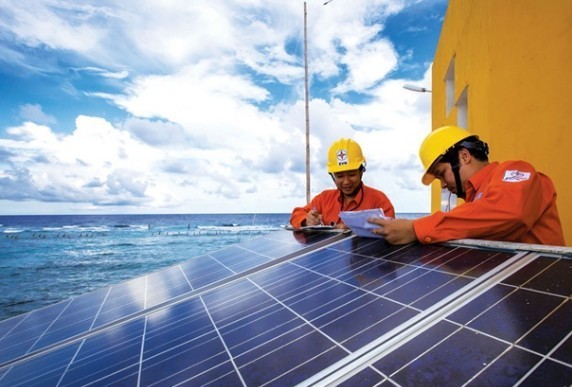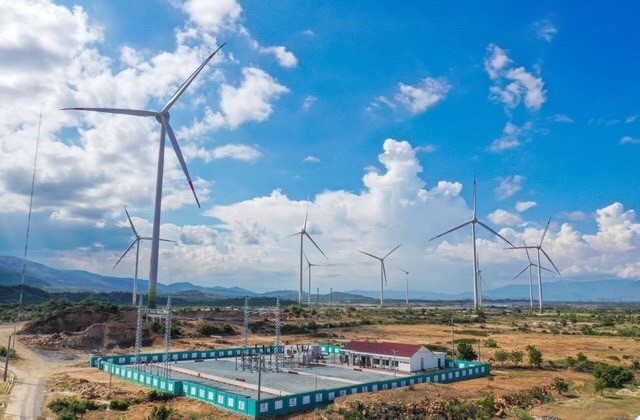
Vietnam switchs to green energy and fights against climate change
Latest
 |
| Shifting to green energy and fighting against climate change is an inevitable tendency of nations around the world. (Source: EVN) |
Government’s effort
According to the World Bank (WB)’s Vietnam Country and Climate Development Report (CCDR) released in early July, Vietnam is one of the most vulnerable countries in the world to climate change. The impacts of climate change have been more variable, disrupting economic activity and weakening Vietnam's growth.
According to calculations, Vietnam lost 10 billion USD in 2020, equivalent to 3.2% of GDP due to the impact of climate change. Without appropriate mitigation and adaptation measures, it is estimated that climate change will cost Vietnam around 12-14.5% of GDP annually by 2050 and could cause approximately one million people into extreme poverty by the year 2030.
The World Resources Institute's analysis on the impact of floods on GDP shows that Vietnam ranked 4th out of 164 countries surveyed in terms of the floods’ serious damage to the economy. Therefore, the policy of proactively adapting to climate change has always been promoted by the Party and Government.
On July 26, 2022, Deputy Prime Minister Le Van Thanh signed Decision No. 896/QD-TTg approving the "National Strategy on Climate Change until 2050". The overall objective of the Strategy is to proactively and effectively adapt to climate change, reduce greenhouse gas emissions to net zero, and deal with vulnerabilities and risks caused by climate change.
On July 25, 2022, Deputy Prime Minister Le Van Thanh also signed Decision No. 888/QD-TTg approving the Scheme on tasks and solutions to implement the results of the 26th Conference of the parties (COP26) of the United Nations Framework Convention for Climate Change (UNFCCC)
Shifting energy towards green growth
At the Conference "The COP26’s impact on energy transition towards green growth" on August 17, Deputy Minister of Industry and Trade Dang Hoang An said that Vietnam's energy and electricity demand in the coming years will increase rapidly along with the growth rate of the economy.
S&P Global Rating has just upgraded Vietnam's long-term national confidence rating to BB+, ranked its outlook as "Stable" and forecasted that Vietnam's GDP growth in 2022 would be at 6.9%, along with the long-term tendency of 6.5-7% from 2023.
Therefore, according to Deputy Minister Dang Hoang An: "To meet the requirements of economic development and the goal of becoming a high-income country by 2045, Vietnam has been building a strong energy transition program until 2050. Traditional fossil energy sources will be gradually switched to green, clean energy sources, reducing greenhouse gas emissions, and fighting against climate change”.
In the last 3 years, Vietnam has strongly developed renewable energy, especially solar and wind power, with more than 16.5 GW of solar power capacity connected to the national electricity grid and nearly 4 GW of onshore and nearshore wind power. If 20.6 GW of hydropower is included, electricity from renewable energy in Vietnam currently accounts for 52.2% of the nationwide installed capacity.
In a recent interview with the media, Mr. Hoang Tien Dung, Director of the Department of Electricity and Renewable Energy (Ministry of Industry and Trade), said that in order to achieve the goals of green, sustainable and economic development, adapting to climate change, the Government has been promoting the transformation of the energy industry in the spirit of promoting internal resources, while enhancing cooperation and support from development partners. In particular, the sources using fossil fuels have been gradually reduced, and priority has been put on the development of renewable energy and new and clean energy sources.
By the end of 2021, the total installed capacity of wind and solar power sources has reached 20,670 MW, accounting for about 27% of the total installed capacity of the whole system. The electricity output from this power source was 31.5 billion kWh, accounting for 12.27% of the total electricity production of the whole system.
In order to concretize the National Green Growth Strategy, on July 22, the Prime Minister approved the National Green Growth Action Plan for the 2021-2030 period with 18 groups of topics.
 |
| Wind Power Project No. 5 - Ninh Thuan of Trungnam Group in Phuoc Huu Commune, Ninh Phuoc District, Ninh Thuan Province. (Source: Trungnam Group) |
Also at the same conference, Deputy Minister of Planning and Investment Nguyen Thi Bich Ngoc emphasized the roadmap for green and sustainable energy transition to ensure national energy security and achieve socio-economic development goals in line with the national master plan and plan for each sector and field.
In order to shift energy in a sustainable way, the Deputy Minister of Planning and Investment called upon the support from developed countries through financial and technical assistance. Besides, the inspection and supervision work to develop an alternative route, closing the polluting production facilities and carbon-emitting infrastructure are also needed.
It is known that the Ministry of Industry and Trade has coordinated with ministries and sectors to do research and make plans and submit to the Prime Minister the National Power Development Plan for the 2021-2030 period, with a vision to 2045 (“PDP VIII”).
The Plan aims at maximizing and developing at relevant level the domestic energy resources for electricity production, such as natural gas and renewable energy; minimizing coal-fired power plants while reducing the CO2 emissions at the lowest level, not developing more new coal-fired power plants after 2030, and considering shifting some power sources to using liquefied natural gas (LNG) in the coal-use planning.
Coal and gas thermal power plants will be gradually switched to using biomass, ammonia or hydrogen when the technologies have been verified and commercialized. At the same time, it is necessary to promote the development of wind and solar power sources, prioritizing the development of renewable energy projects directly supplying electricity to industrial production facilities and residential areas, various types of pumped-storage hydroelectricity and hydroelectricity on irrigation reservoirs, biomass power, solid waste electricity and other renewable energy.
According to Deputy Minister Nguyen Thi Bich Ngoc, we should also take more proactive measures in efficiently using of energy nationwide and better strengthen local capacity in this regard. Vietnam's sustainable, green energy transition needs to receive adequate companionship and support from international organizations, developed partners and corporations around the world.
| 8 tasks and solutions to realize Vietnam’s commitment at COP 26: 1- Completing synchronizing mechanisms, policies and laws, promoting reformation of administrative procedures, improving the investment environment. 2- Focusing on developing new renewable energy, zero-emission sources; energy storage technology and carbon capture, storage and use technology. 3- Promoting emission reduction in transportation and mitigating greenhouse gas emissions in building materials production; green urban development and construction. 4- Developing ecological, circular, low-carbon agriculture; sustainably protecting, conservating, using and developing forest. 5- Protecting and restoring natural resources and developing natural ecosystems. 6- Actively adapting to climate change. 7- Researching science, enhancing innovation, promoting capacity and communication. 8- Promoting climate diplomacy. |

















